Categories: Featured Articles » Interesting electrical news
Number of views: 34755
Comments on the article: 6
Infrared heating systems
How is heat transferred
The physical process of heat transfer from one physical body to another is called heat transfer. Heat is transferred from a hot physical body to a cold one either through direct contact or through a partition.
Thermal energy will be transferred until the temperatures of the physical bodies are equal. In physics, this condition is called thermodynamic equilibrium. Heat transfer usually occurs from a hot to a cold body, which is fully consistent the second law of thermodynamics. According to this law, everyone works heating systems.
In terms of physics, there are three elementary types of heat transfer: thermal conductivity, convection and thermal radiation. But in their pure form, individually, they practically do not occur, in general, heat is transmitted by a combination of simple types. Three types of heat transfer are mainly distinguished: heat transfer, heat transfer, and convective-beam heat transfer method.
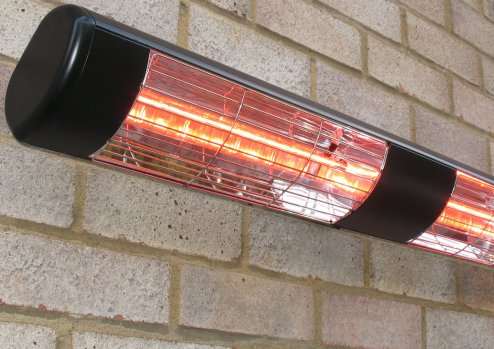
How traditional heating systems work
Traditional heating systems include those systems that use some kind of fuel. Currently, gas is most often used, although liquid and solid fuels are used in some cases. But regardless of the type of fuel, the principle of operation of all traditional systems is the same. The heat from combustion of fuel heats up coolantwhich comes in heating radiators and heats the air in the room. Water is used as a heat carrier in traditional heating systems; therefore, such systems are called water.
By all laws of physics, warm air rises up, and cold air naturally moves down. Such air movement is none other than the one mentioned above. convection. This cold air just creates cold floors, which has to be eliminated by the device of "warm floors". If the room is high enough (production building, auditorium or sports hall, etc.), then the heating of the entire volume lasts long enough, air stratification is created.
The rising warm air creates a draft in the room, in addition, heat losses through the roof and walls increase, the heat simply leaves the building. In this case, they say that we heat the street. The people below are in a zone of cold air.
Figure 1 schematically shows the heat distribution during the operation of a traditional heating system.
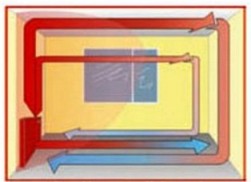
Figure 1. Heat distribution during operation of a traditional heating system
How are traditional water heating systems
The main device of the water cooling system is boiler, most often gas. The water heated in the boiler is piped to the radiators - radiators. For the circulation of water in the system is installed pumpif circulation is forced, although circulation may be natural. In this case, you can do without a pump.
In addition to these basic devices and parts, the water heating system also includes many "auxiliary", but necessary parts. First of all, it is an expansion tank to compensate for the thermal expansion of water, fittings for connecting pipes, air valves and much more, necessary for the normal operation of the entire system as a whole.
In an individual house for the installation of a gas boiler, an additional room is required, equipped with a ventilation system and a chimney, not to mention the gas supply system. In the case of district heating, the construction of a large boiler room and the laying of a whole network of heating mains are required. The whole system is expensive and complicated.But in some cases, for example, for a small country house, and if there is no gas nearby, you have to make an electric heating system.
The most common in such cases are electric boilers for water heating or various electric heaters. First of all, these are oil radiators, electric fireplaces and fan heaters of various designs. The principle of operation of these devices is also convection, as in water heating systems: first the air is heated, and only then the walls, furniture, people. Such a system is inefficient and inefficient.
Infrared heaters
Various infrared heating appliancesthat provide rational and economical heating of premises in a wide variety of conditions. Next will be considered some of these devices, the principles of their operation.
From a natural point of view, traditional heating systems do not work properly. First, the air heats up, and then everything else. Under natural conditions, everything happens the other way around.
The natural source of heat on Earth is the sun. The sun's rays have a very wide spectrum, but it is its infrared component that heats the Earth, people, plants and all objects, and from them the air heats up and creates comfortable conditions for human life.

It is on this principle that they work infrared heaters. The air for infrared radiation is absolutely transparent, therefore infrared rays freely reach heated surfaces and objects.
Figure 2 schematically shows the heat distribution when using an infrared heater.
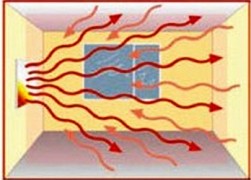
Figure 2. Heat distribution using an infrared heater
Infrared radiation represents electromagnetic waves with a wavelength in the range of 1 * 10-6 ... 1 * 10-3 microns. The intensity of thermal radiation depends on the wavelength of infrared radiation: short-wave rays are obtained at a temperature of the radiating body above 750 ° C. Depending on the application and design, the temperature of the emitting element of the infrared heater can be in the range of 100 ... 950 ° C.
Outboard infrared heaters
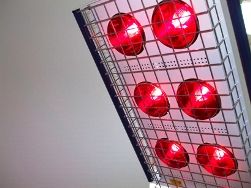 In a fairly high room, water heating systems, as mentioned above, are ineffective, because all the warm air rises.
In a fairly high room, water heating systems, as mentioned above, are ineffective, because all the warm air rises.
With a ceiling height of 2.5 ... 3.6 m, low-temperature infrared outboard heaters with a radiator temperature in the range of 100 ... 120 ° C will be quite effective and economical.
To achieve uniform heating of the room, to avoid the appearance of warm and cold zones, it is required to carry out heating by several heaters, the total power of which must correspond to the heat loss of the building. If the ceiling height is 4 m or more, then it is quite acceptable and safe to use heaters with a radiating surface temperature of up to 200 ° C and above. Such heaters are called high temperature.
The design and principle of operation of the emitters is such that their installation is possible at any height. If the room is very large, such as a warehouse or a hangar, then infrared heaters can be installed only above the work sites, in places where people are located, which saves energy.
Panel radiant heating system:
Low temperature heater It is a metal box with a distributed heater placed inside it. The radiating surface is treated with special materials providing the maximum intensity of thermal radiation, emission of thermal radiant energy. The coefficient of thermal emission from the most advanced heaters reaches 90%. To a large extent, the radiating surface is promoted by the fact that the radiating surface becomes embossed, bumpy. This allows you to increase its area by at least 2.5 ... 3 times.
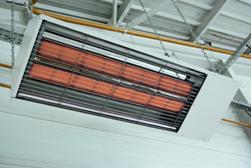 High temperature heaters also represent a box-shaped case, inside of which one or more heating elements are located. The heat of these elements is transferred to the aluminum profile, the radiating surface of which is coated with special ceramics, which allows to reduce the temperature of the radiating surface by increasing the emission coefficient of the radiation flux.
High temperature heaters also represent a box-shaped case, inside of which one or more heating elements are located. The heat of these elements is transferred to the aluminum profile, the radiating surface of which is coated with special ceramics, which allows to reduce the temperature of the radiating surface by increasing the emission coefficient of the radiation flux.
The space between the casing and the heating elements is filled with a heat-resistant high-quality heat insulator, thereby achieving full Fire safety the entire device as a whole. Such thermal insulation is characteristic of both high-temperature and low-temperature heaters.
Some companies, for example Thermatex, Armh5, Rockfon, produce infrared heaters for installation in cassette ceilings, which once again says fire safety infrared heaters.
One of the new products on the market are heat-emitting mirrors. Their reflective layer is also a heating element. The maximum surface temperature of the mirror does not exceed 75 ° C, which is completely safe for others. In the sauna or in the bathroom, such a mirror does not fog up, does not change the natural level of humidity and fits perfectly into the design of the room, it is environmentally friendly.
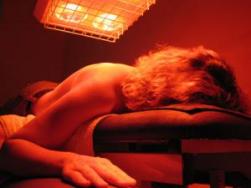 As various studies have shown, the thermal frequency spectrum of infrared heating is absolutely safe for humans. This is confirmed by studies not only of manufacturers, but also the results of independent examinations. The safety of infrared devices is also confirmed by certificates of conformity issued by both Russian and foreign sanitary services.
As various studies have shown, the thermal frequency spectrum of infrared heating is absolutely safe for humans. This is confirmed by studies not only of manufacturers, but also the results of independent examinations. The safety of infrared devices is also confirmed by certificates of conformity issued by both Russian and foreign sanitary services.
Various firms produce infrared heaters mainly of the ceiling type, suitable for use in any premises: industrial, residential, agricultural, wet and even explosive.
Many companies also produce wall-mounted heaters, floor-mounted and portable, mounted on racks. Infrared heaters in which gas is used are known.
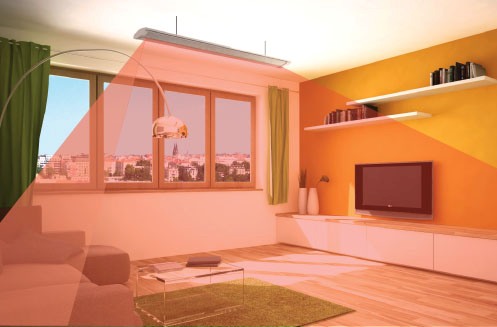
Infrared picture heaters
Recently, as additional local heaters, various elements of the interior are becoming more and more popular: painting heaters, baseboards, warm wall panels.
Such heating elements consist of carbon fibers connected in parallel with each other. There are not one or even two hundred such threads in the heaters, due to which each thread works without any overloads, the power allocated by it is very small. Therefore, the occurrence of overloads and overheating is excluded, the reliability of such heaters is very high, the service life reaches 10 years or more.
The advantages of infrared heaters
One of the advantages of infrared heaters is that the heat, creating drafts and raising clouds of dust, does not go under the ceiling, as in the case of convection heating systems. The level of electromagnetic fields of infrared systems is much lower than that of many household electrical appliances, oxygen is not burned, air humidity in the room does not decrease, it remains at a natural level.
The heat in the room is felt immediately after switching on, the surfaces of surrounding objects almost immediately become warm. In this case, it is not necessary to uniformly heat the entire room, it is possible to create separate comfortable zones, for example, near a TV or above a desk or computer desk.
The undoubted advantage of infrared equipment is its small size and mobility. Due to these parameters, usable area is saved, equipment is easily moved, installed and dismantled. Infrared heaters are very effective in buildings with poor thermal insulation and high ceilings, little effect on ventilation.
Installation of infrared heaters of appropriate power is possible even in open areas. For example, over tables in a summer cafe.Unlike a traditional water heating system, installation of complex expensive equipment is not required: pipes, boilers, pumps, etc. When installing infrared heating, problems such as defrosting pipes when the system is turned off disappear. When you turn on the electricity again, infrared heating will work again, as if nothing had happened.
With the help of modern programmable thermostats, it is possible to maintain the temperature in the range of 5 ... 30 ° C, setting it for each room separately.
Compared with convection heaters, IR devices are 20 ... 25% more economical, and in the case of using a two-tariff payment for electricity, the savings can reach 40 ... 45%.
Boris Aladyshkin
See also at e.imadeself.com
:
